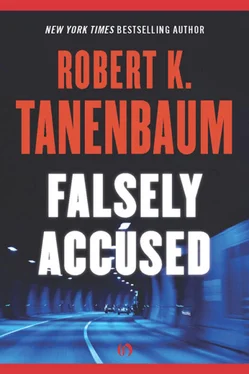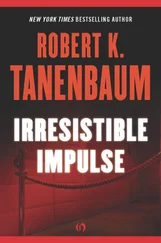Robert Tanenbaum - Falsely Accused
Здесь есть возможность читать онлайн «Robert Tanenbaum - Falsely Accused» весь текст электронной книги совершенно бесплатно (целиком полную версию без сокращений). В некоторых случаях можно слушать аудио, скачать через торрент в формате fb2 и присутствует краткое содержание. Год выпуска: 2010, Издательство: Open Road Integrated Media, Жанр: Криминальный детектив, на английском языке. Описание произведения, (предисловие) а так же отзывы посетителей доступны на портале библиотеки ЛибКат.
- Название:Falsely Accused
- Автор:
- Издательство:Open Road Integrated Media
- Жанр:
- Год:2010
- ISBN:нет данных
- Рейтинг книги:5 / 5. Голосов: 1
-
Избранное:Добавить в избранное
- Отзывы:
-
Ваша оценка:
- 100
- 1
- 2
- 3
- 4
- 5
Falsely Accused: краткое содержание, описание и аннотация
Предлагаем к чтению аннотацию, описание, краткое содержание или предисловие (зависит от того, что написал сам автор книги «Falsely Accused»). Если вы не нашли необходимую информацию о книге — напишите в комментариях, мы постараемся отыскать её.
Falsely Accused — читать онлайн бесплатно полную книгу (весь текст) целиком
Ниже представлен текст книги, разбитый по страницам. Система сохранения места последней прочитанной страницы, позволяет с удобством читать онлайн бесплатно книгу «Falsely Accused», без необходимости каждый раз заново искать на чём Вы остановились. Поставьте закладку, и сможете в любой момент перейти на страницу, на которой закончили чтение.
Интервал:
Закладка:
Robert Tanenbaum
Falsely Accused
ONE
With a wet and embarrassing sound, a sound like no other, a human brain came loose from its skull and, dripping thick, clotted blood and fluid, hung suspended in the hands of the chief medical examiner of the City of New York. The brain’s former owner (or rather, the being that once sprang from it) was named Jeffrey Zimmerman, late a stockbroker and arbitrageur, and a famous near-billionaire of the day, which was one reason why his autopsy was being performed by the chief medical examiner himself, Dr. Murray Selig, instead of by one of Selig’s many subordinates.
Another reason was that Selig loved doing autopsies. He especially loved probing the kishkas of the rich and famous, or of those meeting their ends in some spectacular or bizarre manner, but he would also drop into the morgue of an afternoon and whip through a couple of overdosed whores with as much elan. He was good at it too. Dr. Selig was generally considered by his profession to be one of the half-dozen best forensic pathologists in the United States, an opinion that Selig himself rarely lost a chance to share with others. As a result of this skill and fame, Selig often had an audience of med students, trainee pathologists, or visiting coroners to watch him work. He didn’t mind that either; a bit of a showman, Selig, another reason why he had chosen this particular branch of medicine. He liked appearing before press conferences and giving the straight poop on how some particular leading light had been switched off.
The audience today, three first-year Downstate students, one now looking quite green, and the medical examiner of a county in Texas, saw a shortish, perky-looking man in his late forties, with an aureole of frizzy hair over a balding forehead, big black horn-rims, and a neat brush of a mustache. Dressed in a slick rubber apron and green scrub clothes, he moved with a springy step across the damp floor of the autopsy room. They watched him weigh Zimmerman’s brain.
Selig read the weight into a microphone suspended over his head: 1,352 grams, about average for a man. He then placed the organ on a steel tray and began to investigate what had until the night before last been quite the most valuable three pounds of meat in Manhattan. Now he became totally absorbed. The morgue staff, the deiners and the other medical examiners, knew that Dr. Selig was in no circumstances to be interrupted during an autopsy, which was why when the call came through from the Mayor’s office that afternoon, nobody roused the pathologist from his close examination of the stockbroker’s brain.
Selig continued to probe and snip at the thing, assessing the extent of the damage to it and telling the tape what he was finding. The audience watched, breathless. The Cause of Death, the apotheosis of any autopsy, was about to emerge. Zimmerman had received a heavy blow to the base of the skull. Selig had already recorded the depressed fracture of the right posterior fossa and the attendant tearing of the membranes surrounding the brain. Now he peeled away those membranes, the dura, the arachnoid, the pia, to expose the cheesy substance of the crown of creation itself. He noted the swelling, the extensive hematomas of the occipital lobes. He chased a ruptured artery and the purplish damage it did deep into the midbrain. He announced: death from massive cerebral hemorrhage. The only problem remaining was to determine … ah, here it was: bruising and smaller hematomas at the point of the frontal lobes, the part of the brain just behind the forehead. There had been no injury to the forehead itself, which meant that these particular bruises were contra-coup injuries. Zimmerman’s brain had been violently thrust against the inside front of his skull, evidence that this injury had been caused by a fall. Nobody, it seemed, had bashed Zimmerman’s head in, although there were plenty in town who wouldn’t have minded the chore. Mr. Z. had fallen, like a great tree, and cracked the back of his head against the porcelain rim of one of the six toilets in his Sutton Place duplex. How he had come to fall like that still remained a puzzle, the solution to which Selig believed waited on the completion of the various drug tests he had already ordered. That the late Zimmerman enjoyed a creative use of the pharmacopeia, both legal and illegal, was a fact well known in Manhattan’s tonier haunts.
A half hour later, Selig was back in his office, having put away his apron and green scrubs, but still exuding a faint redolence of the morgue.
“The press is out in force,” said his secretary.
“What, on the Zimmerman?”
“Uh-huh. Crews from the three networks and a local, plus the print people. They’re in the big conference room. And the Mayor wants to see you. It’s urgent.”
Selig laughed. “I bet. Zimmerman was a big contributor. Well, he can catch it on TV like everyone else.”
“What was it?” asked the secretary. A neat part of her job was being the second person in the City to know how famous people died. She had worked for Selig for the whole year he had been C.M.E. and had developed a mild crush on the man, not least because of his free and breezy manner and his willingness to share tidbits of information with the peasants.
“Fall,” said Selig. “Probably doped to the gills, but we won’t know that for sure until tomorrow. Get the car around, would you? I’ll leave for the Mayor’s right after I get rid of these guys.”
Later, relaxing in the back of the official car as it sped downtown, Selig thought that it had gone reasonably well, and that, had the Mayor actually caught the press conference live, he would have had nothing to complain about. Selig rather enjoyed the repartee with reporters and flattered himself that he was good at it. He had restricted himself to what he actually knew about Zimmerman’s death, and declined to speculate about the rumors of wild drug orgies in the broker’s home. For the hundredth time he had lectured the press that the M.E.’s job was solely that of determining cause and circumstances of death; whether that death included foul play or not (“Could he have been pushed, Dr. Selig?”) was a job for the police.
So if the Mayor wanted to talk to him about Zimmerman, he was clean, except for the drug business, in which case he could truthfully say that he didn’t know-yet. When the results came in, the Mayor might want him to cover them up, which, of course, he would refuse to do. Although on paper the medical examiner reported through the health commissioner to the Mayor of New York, Selig held to the older and unwritten tradition that the coroner was, as that older title implied, the agent of the crown, of the sovereign alone-in England, the King, in America the People. If the Mayor did not understand this yet, too bad for him.
As the car swung into the South Street Viaduct for the run up to City Hall, it occurred to Selig that tomorrow, July 21, would mark exactly a year since he had taken over as chief medical examiner. Maybe the Mayor was planning a ceremony. A little chat about the deceased contributor, followed by a little wine and cheese? The Mayor had a fondness for ceremony, or rather, for having his face exhibited on television during ceremonies. Selig caught his reflection in the glass of the window; he adjusted his tie and brushed off his lapels. He was somewhat miffed at not having been told about it in advance, although that too was typical of this Mayor. Selig sniffed at his hands, which he had remembered to scrub thoroughly before leaving Bellevue. No remnant of the morgue remained, just a faint scent of green soap.
They arrived. Selig got out and was shown directly to the Mayor’s great office, where there occurred a ceremony of a sort after all. In the presence of Angelo Fuerza, the commissioner of Health, and on the basis of letters of complaint from that official and from the district attorney of New York, Sanford Bloom, the Mayor told Selig that he was fired.
Читать дальшеИнтервал:
Закладка:
Похожие книги на «Falsely Accused»
Представляем Вашему вниманию похожие книги на «Falsely Accused» списком для выбора. Мы отобрали схожую по названию и смыслу литературу в надежде предоставить читателям больше вариантов отыскать новые, интересные, ещё непрочитанные произведения.
Обсуждение, отзывы о книге «Falsely Accused» и просто собственные мнения читателей. Оставьте ваши комментарии, напишите, что Вы думаете о произведении, его смысле или главных героях. Укажите что конкретно понравилось, а что нет, и почему Вы так считаете.












